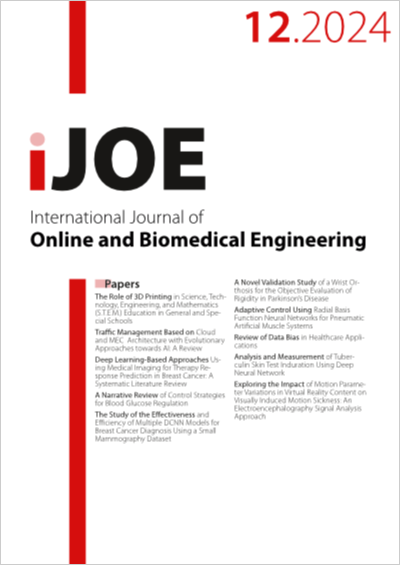A Novel Validation Study of a Wrist Orthosis for the Objective Evaluation of Rigidity in Parkinson’s Disease
DOI:
https://doi.org/10.3991/ijoe.v20i12.50429Keywords:
Parkinson's Disease, Orthosis, Objective Quantification, Rigidity, PhysiotherapyAbstract
Parkinson’s disease (PD) is a neurological condition affecting millions, marked by mobility issues and characterized by motor and non-motor symptoms, including tremors, bradykinesia, postural instability, and rigidity. Diagnosis often relies on subjective assessments such as the Movement Disorder Society Unified PD Rating Scale (MDS-UPDRS). This study focuses on validating a wrist orthosis designed to quantify rigidity in PD patients objectively. Developed at the Center for Innovation and Technological Evaluation in Health (NIATS), the orthosis integrates a Faulhaber linear motor (LM 2070-080-11) and microcontroller (MCLM 3006 S RS). Calibration experiments, including varied mass assessments, established the orthosis’s reliability. Results indicated a newly calculated force constant of 14.28 N/A, 18.49% higher than the manufacturer’s value, with a strong Pearson correlation coefficient (0.9997189). The orthosis detected masses ranging from 39.07 to 812.64 grams without yielding. Angular displacement calibration, utilizing a GP10 goniometer and Myosystem-Br1 software, demonstrated linearity, supported by Pearson coefficients of 0.9995091 and 0.995259. These findings underscore the orthosis’s potential as a reliable tool for measuring rigidity in PD patients, promising advancements in physiotherapy and disease monitoring.
Downloads
Published
How to Cite
Issue
Section
License
Copyright (c) 2024 MSc. Caio Tonus Ribeiro, MSc. Daniel Hilário da Silva, MSc. Leandro Rodrigues da Silva Souza, José Renato Munari Nardo, Prof. Dr. Adriano Alves Pereira

This work is licensed under a Creative Commons Attribution 4.0 International License.



